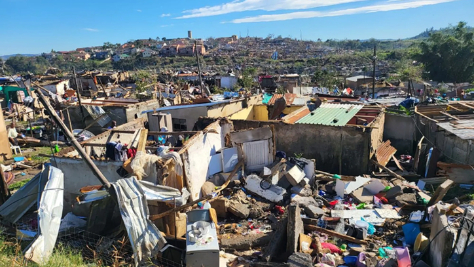There has been an outbreak of severe storms and at least two tornadoes on Monday afternoon, affecting parts of KwaZulu-Natal such as New Castle, Utrecht, Ballito, and Tongaat.
The sudden onset of these extreme weather events, part of a broad spell of severe weather being experienced around South Africa this week, underscores the importance of understanding how tornadoes form and potential impact of climate change on their frequency and intensity. Kevin Rae, Chief Forecaster for Disaster Risk Reduction at the South African Weather Service, said in a statement that “severe weather was predicted to an upper air-cut off low system. This system triggered severe storms, heavy rainfall, flooding, and heavy snowfall in various regions, including the Eastern Cape and KwaZulu-Natal.” According to the US National Center for Atmospheric Research, a tornado is a rapidly rotating column of air that extends from a thunderstorm to the ground. The formation of a tornado requires specific atmospheric conditions.(BBC)
The risk of experiencing a tornado is deadly. The damage caused by two tornadoes is immense. The destruction of homes and properties and even death can take residents by surprise. The formation of a tornado can be attributed to warm air heating up the ground and stirring the colder air up above. Scientists will blame climate change; ordinary people will call it an act of God. The frequency of thunder storms and tornadoes can be attributed to an increase in warm air combatting cold air. This is climate change created by an increase in carbon dioxide in the earth’s atmosphere as a result of the use of fossil fuels. An imbalance of releasing exhaust fumes from car engines, factories that burn coal and refineries leads to a build up in the atmosphere.
Wind shear is a significant factor in tornado formation. It involves a change in wind speed and direction with height. When winds at different altitudes blow at different speeds or in different directions, it can create a rotating column of air. A lifting mechanism, such as a cold front or a low-pressure system, is needed to push the warm air upwards. As the warm air rises, it cools and condenses to form thunderstorms. Tornadoes most commonly form from supercell thunderstorms, which are characterized by a rotating updraft called a mesocyclone. Under the right conditions, the mesocyclone can tighten and intensify, forming a tornado.(BBC)
When the formation of a tornado takes place, the weight of surrounding objects or buildings becomes irrelevant as they are picked up in the weighty atmosphere and flung to further reaches. Tornadoes are deadly and can inflict immeasurable damage on the environment of the area where they strike. Although the increase in these natural phenomena is attributed to climate change, they are a worrying sign that all life and also the ecosystem is fragile. Thunder storms, tornadoes and heavy snow are happening no one can feel safe outdoors. Disaster can strike at any time. So, is it time to ease out fossil fuels, in favour of renewables? Possible but it needs to be done in respect and concern for the environment.
Everyone remembers “that sound” when a tornado slammed into Tongaat somewhere around 4.30pm on Monday, 3 June. It was a terrifying, screeching, overwhelming sound. Some residents described it as akin to a jet plane about to crash. Others likened it to a rumbling goods train about to plough into their homes. Patience Denge called it a “snake”. Though the sun had not set, Denge remembers that the sky was black. The rain was belting down, then it turned to ice. “The thing was very dark… It looked like there was a fire inside it and it was moving like a snake. Now I have nothing. Never mind my house. My ID document is gone. My daughter’s school books are gone. Our clothes are gone.”(IOL news)
When a tornado takes shape in the air it generates static electricity through lightning. The power of a tornado is just that: raw power. It absorbs everything in its part and then discards with it. It is victims like Patience Denge who suffer the consequences. The price the freakish weather exacts is usually material goods that can replaced if charitable foundations, the government and private donors are willing to replace them. The destruction and fear routed by the storm, tornadoes and hail stones can be repaired if the right materials and finances are there. The death toll was relatively low, but depending on frequency of the storms this is a toll of deaths that can only rise. The focus should be on building underground shelters like the ones in the US and other places to protect resident from the tornadoes’ wrath.
Only time will what South Africans as a whole have learned from the disaster that struck in Tongaat.
Article written by:
Yacoob Cassim
Journalist at Radio Al Ansaar






